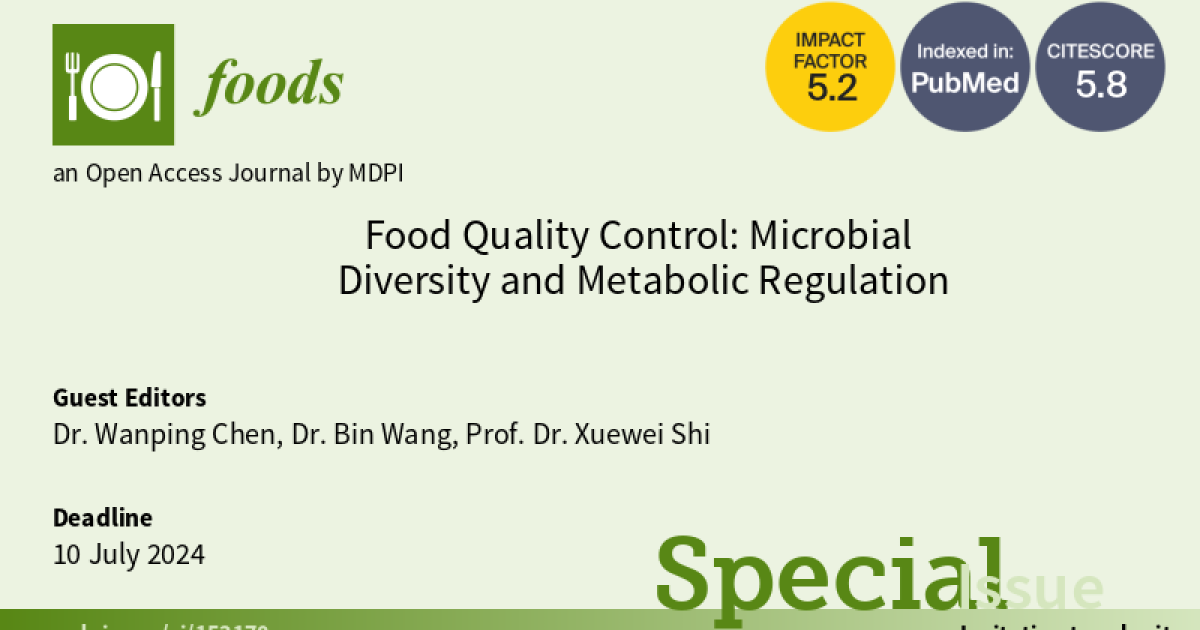Food Quality Control: Microbial Diversity and Metabolic Regulation
A special issue of Foods (ISSN 2304-8158). This special issue belongs to the section "Food Quality and Safety".
Deadline for manuscript submissions: closed (10 October 2024) | Viewed by 30193

Special Issue Editors
Interests: fungi; Asepergillus; secondary metabolites; food fermentation
Special Issues, Collections and Topics in MDPI journals
Interests: microbiology; transcriptome; genome; metabolome; proteome
Special Issues, Collections and Topics in MDPI journals
Interests: microbiology; food fermentation; secondary metabolites; metagenomics; flavors
Special Issues, Collections and Topics in MDPI journals
Special Issue Information
Dear Colleagues,
Food quality control is always a hot topic in the food industry, especially in fermented foods. During food fermentation, microbial communities vary with regular processes, accompanied by converting substrates, such as carbohydrates, proteins, and lipids, into raw materials and beneficial metabolites (organic acids, alcohols, amino acids, peptides, fatty acids, etc.). These beneficial metabolites have a main nutritional composition and sensory and functional properties. Obviously, microbial diversity and metabolic regulation in fermented foods have become the main factors controlling food quality.
Therefore, this Special Issue aims to present recent advances in microbial diversity and the metabolic regulation of fermented foods. We encourage the submission of manuscripts that include, but are not limited to:
- the succession of microbial communities during food fermentation;
- dynamic changes in organoleptic, nutritional, and functional characteristics during food processing;
- the relationship between microbes and the metabolic activities of fermented products;
- the effects of microbes on food safety and quality;
- main metabolisms and their regulation during food fermentation;
- the industrial transformation of traditional fermented food;
- screening and applying functional microbes;
- the correlation of microbes with environment and gut health;
- the development of characteristic functional metabolites in fermented foods.
Dr. Wanping Chen
Dr. Bin Wang
Prof. Dr. Xuewei Shi
Guest Editors
Manuscript Submission Information
Manuscripts should be submitted online at www.mdpi.com by registering and logging in to this website. Once you are registered, click here to go to the submission form. Manuscripts can be submitted until the deadline. All submissions that pass pre-check are peer-reviewed. Accepted papers will be published continuously in the journal (as soon as accepted) and will be listed together on the special issue website. Research articles, review articles as well as short communications are invited. For planned papers, a title and short abstract (about 250 words) can be sent to the Editorial Office for assessment.
Submitted manuscripts should not have been published previously, nor be under consideration for publication elsewhere (except conference proceedings papers). All manuscripts are thoroughly refereed through a single-blind peer-review process. A guide for authors and other relevant information for submission of manuscripts is available on the Instructions for Authors page. Foods is an international peer-reviewed open access semimonthly journal published by MDPI.
Please visit the Instructions for Authors page before submitting a manuscript. The Article Processing Charge (APC) for publication in this open access journal is 2900 CHF (Swiss Francs). Submitted papers should be well formatted and use good English. Authors may use MDPI's English editing service prior to publication or during author revisions.
Keywords
- food fermentation
- microbial diversity
- food quality
- metabolic engineering
- metabolic regulation
- food microbiology
- microbe application
- food flavors
Benefits of Publishing in a Special Issue
- Ease of navigation: Grouping papers by topic helps scholars navigate broad scope journals more efficiently.
- Greater discoverability: Special Issues support the reach and impact of scientific research. Articles in Special Issues are more discoverable and cited more frequently.
- Expansion of research network: Special Issues facilitate connections among authors, fostering scientific collaborations.
- External promotion: Articles in Special Issues are often promoted through the journal's social media, increasing their visibility.
- Reprint: MDPI Books provides the opportunity to republish successful Special Issues in book format, both online and in print.
Further information on MDPI's Special Issue policies can be found here.






